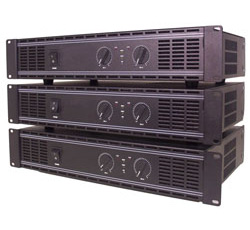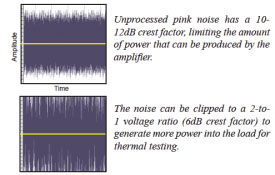
References to “under-powering” are based on the amplifier having insufficient peak voltage output to pass the signal without clipping – there is plenty of power, but insufficient “peak” room.
I recommend limiting the input power to no more than 1/2 (-3 dB) of the continuous rating for reliable operation. In the preceding example this would mean using an 800-watt amplifier, feeding it typical program material (10-14 dB crest factor) and driving it just to the brink of clipping as a maximum. Under these conditions, the amplifier will be producing about 80-watt continuous or less into the loudspeaker, most of which will be dissipated as heat.
Since the amplifier has a potentially large output, care must be taken to assure that low crest factor program material is not turned up too loud as it could damage the loudspeaker.
Finally, it’s important to realize when you are reaching the point-of-diminishing-returns when turning up the volume on a sound system. Each 40 percent increase in applied RMS voltage to the loudspeaker produces twice the input power, and only a slight (+3 dB) increase in sound level.
Remember that with audio it is the proportional change that matters. As the volume of the system is increased in 3 dB steps, eventually the limits of heat dissipation are reached and the next 3 dB “breaks the camel’s back.” A loudspeaker is very near its maximum loudness at one-half of its rated power. There is nothing to be gained by going further and the loudspeaker will likely suffer permanent damage.

Advancements in automotive technology have produced vehicles with greater efficiency and lower operating cost due to reduced waste.
The audio industry should have a similar goal – achieving the desired SPL using less amplifier power. As efficiencies increase the need to dissipate lots of power should diminish, as should our fascination with high power ratings.
Conclusion
Loudspeaker power ratings have nothing to do with how a loudspeaker sounds. While usually referenced to applied power, the acoustic level is a function of the RMS voltage impressed across the loudspeaker’s terminals by the amplifier, and a voltage reference should be used for specifying the sensitivity of the loudspeaker.
The power consumed by the loudspeaker is a byproduct of its resistance, and it must be dissipated in the form of heat. High efficiency is more desirable than high power handling, and there is nothing inherently beneficial in a loudspeaker being able to consume lots of power.
As long as end users hold high power ratings in high regard, there will pressure on manufacturers to devise rating methods that produce big numbers, while improvements in loudspeaker efficiency go unheralded.
